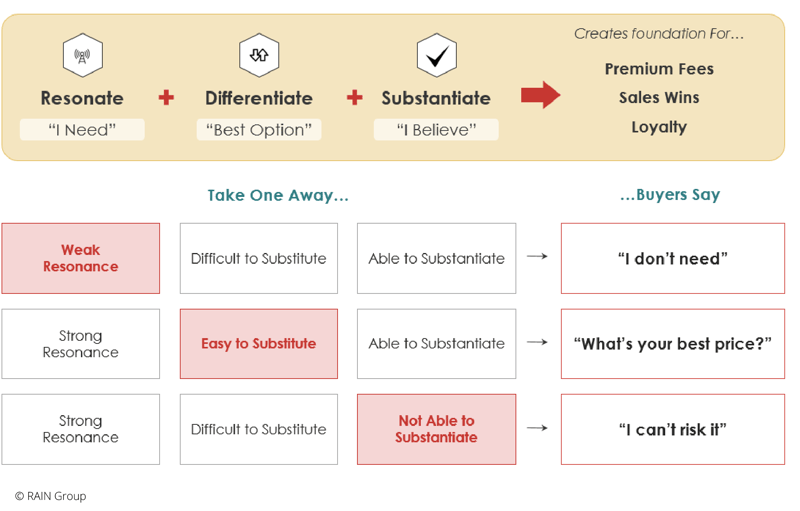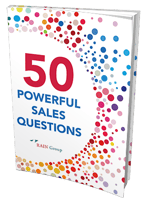What Is a Value Proposition Positioning Statement?
A value proposition positioning statement is a compelling, tangible description of how a company or individual will benefit from buying something specific or buying from you in general.
Even when people know their value, many find it difficult to describe it.
Let’s say someone asks you the simple question, “What do you do?”
How do you answer? Of course, you need to get your value across, but as we note here, when communicating your value proposition, you don’t want to deliver the same canned speech for everyone.
What you need to do is craft and share specific nuggets of information you can use to communicate your value. Put all these nuggets together and you have what we call a value proposition positioning statement.
For example, we might start ours with, “We at RAIN Group help companies improve their sales performance. If you want your sellers, professionals, and leaders to sell more, we can help.”
This is the umbrella under which we operate. It’s a nugget of information we use in the early part of conversations. And it’s important nugget: it’s the ultimate reason why clients eventually hire us!
Your value proposition positioning statement should contain factors and specifics meant to sway a potential buyer into choosing you. This means positioning yourself as superior to these three alternatives:
- Doing something themselves
- Choosing someone else to help them
- Choosing to do nothing at all
Obviously, as the conversation moves along, you must communicate more to tip the scales in your favor.
What’s the Difference Between Your Value Proposition and Your Positioning Statement?
A value proposition is the collection of reasons why buyers buy, and from whom. Your value proposition positioning statement is meant to be used in conversation, allowing you to communicate value when you introduce yourself and your company.
Read on for more on how to craft, customize, and deliver an effective value proposition positioning statement.
6 Components of a Value Proposition Positioning Statement
To get a full picture of your value across, you need to be able to cover 6 areas.
1. Target customers
Whom do you serve? What makes for an ideal customer regarding industry, location, size, type and so on? This allows you to resonate with potential buyers if you work with companies and people like them.
Know your target customer so you can craft messages that align with them. In addition, the more you can position specialization for a particular buyer set, the more you typically resonate and differentiate.
2. Need/business problem
What types of needs and business problems do you address? How do you help? This helps prospects understand how and when they should use you.
Don’t just think in terms of business problems. You should also address your audience’s aspirations. Help them understand the benchmark of what’s possible if they work with you. We call this the New Reality.
3. Impact of solving need
What are the rational and emotional benefits of solving the need? Getting this right is a major factor in whether you resonate.
While many sellers focus on the financial ROI of their solutions, the impact you provide is both rational and emotional. The exact impact can range from individual benefits to opportunities that impact the entire organization.
4. Your offerings
What’s your product and service approach? How do you run your company? How do you solve problems and work with customers? Notice that company and offerings are fourth here. Think buying first and selling second and frame your offerings within the context of the needs you can help solve.
5. Proof of concept
How can you demonstrate that your approach has worked to solve similar problems for others? How do you substantiate your claims? How do they know that what you say will happen will actually happen?
Hypotheticals will only get you so far here. Don’t launch into specific case studies right away, but have the information on hand if the conversation continues further. Your proof of concept often hinges on your ability to tell a convincing story about your past successes as succinctly as possible.
6. Distinction
Why is your offering preferable to other options for solving the need? Do you have something special about you that’s worth sharing? Is there some way to highlight how you’re distinct from others?
Example Value Proposition Positioning Statements
With all six of these components in mind, what will your statement look like? The truth is, your statement should be flexible and tailored to your audience. That said, here are two examples to get you started:
Example 1:
“I’m a lawyer with Alex, Franklin, and Stevens. I work on intellectual property matters. My clients are fortune 500 companies.”
While this statement starts to cover who you are and who you work with, it’s too general and not compelling. It mentions target clients, but it doesn’t fulfill the three legs of the value proposition stool: Resonate, Differentiate, and Substantiate.

To review, your value proposition positioning statement should:
- Resonate: Buyers must want and need your solutions
- Differentiate: Buyers must understand why buying from you is superior to other options
- Substantiate: Buyers must know that you can deliver on the results you promise
Let’s look at another example.
Example 2:
“We work with some of the world’s best-known companies to help them protect their brands.
We offer a range of services—but just last week, we helped a client protect their newest releases from counterfeiting in a developing country because we had the contacts on the ground there to make sure their products were protected.
Using our experience in intellectual property law, we also help companies like Nike and organizations like the NBA help protect the value of their brands.
That experience has helped us safeguard millions of dollars in revenue for our clients that otherwise would’ve gone to unauthorized vendors and resulted in costly lawsuits in a foreign country.”
This example offers a more thorough exploration of your value proposition. You resonate by outlining the impact and necessity of your services. You differentiate by sharing the specifics of how you work with your clients. You substantiate by sharing successful outcomes to similar issues.
That said, this value proposition positioning statement would be excessive to deliver all at once. You want to share this information piecemeal. This is why practicing and internalizing your statement is so important—more on that later.
Delivering Your Value Proposition Positioning Statement
Once you’ve assembled all of these components, combine them and practice them as a single, interconnected statement.
Then forget it.
At least, forget delivering it in one slick mini-speech.
If you deliver all six of the building blocks in one breath, the person you’re speaking to will expect an elevator pitch and tune out.
Starting the Conversation
When you introduce yourself and someone asks you, “What do you do?” The best thing to do is start with a few important nuggets that can help you get a conversation flowing.
We started our example with, “We at RAIN Group help companies improve their sales performance. If you want your sellers, professionals, and leaders to sell more, we can help.”
We didn’t yet cover the target market, impact, our distinctions, proof of concept, and so on.
You can do so as the conversation unfolds.
Asking Questions
We might start here and then ask the other person, “That’s us in a nutshell. What do you do?” and they’ll answer, often following our lead and keeping it short. Then we ask questions to learn more.
In the natural flow of conversation, we’re likely to learn enough to share relevant details that will continue to position our value. In addition, ask someone something and they’ll often turn the question right back at you.
Incisive questions are the key to delivering a value proposition positioning statement that resonates with your buyer. The best statements are presented as conversations, and that starts by asking questions that lead the conversation down paths that are of interest to you both.
For example, you might ask, “Can you share any specific examples? And I'm curious to know how it panned out."
Then they’ll tell you the story and say, “What about you? Any examples in my industry?”
You can hit the rest of the building blocks as you continue along in conversation.
Mistakes to Avoid When Delivering Your Statement
Talking, but not saying anything
Be specific! It’s easy to fall into the trap of overloading your statement with buzzwords that ultimately don’t tell potential buyers anything about why they should listen to you. Each part of your statement should provide some sort of value.
Going on for too long
As we’ve pointed out, your value proposition positioning statement should be conversational, sharing information naturally as it comes up. Be confident and decisive when delivering the first key details, then step back and let the conversation evolve further.
Being too clever or silly
Trying to be too clever doesn’t add much to your statement and can cause you to come across as less serious. Don’t overthink it—start by sharing who you are, what you do, and who you do it for.
Being too detailed
It’s smart to be aware of your full suite of offerings, but focus on what’s most likely to be of interest to the buyer. Distill your suite of products and services into relevant categories. For example, you might say, “We focus on consumer banking and investments, insurance, and commercial banking.”
It helps to be able to go into more detail if necessary, but wait until it’s appropriate to do so.
Getting too complicated
Focus on the practical and the easily understood. Unless you’re at a conference talking with industry experts, prioritize ease of communication over demonstrating specific technical knowledge.
Not customizing for your audience
Your value proposition positioning statement is your starting point, not the end-all-be-all of connecting with buyers. Your buyer should know what’s in it for them, and that comes with understanding their needs and adjusting your statement accordingly.
Conclusion
The word “value” is bandied about, often without a cohesive sense of what it means. While it’ll mean something different to each buyer, you should understand the many ways you can provide it.
Once you know your value proposition inside and out, you can use it as the basis for crafting a value proposition positioning statement that actively engages potential buyers and sets the stage for deeper sales conversations.







